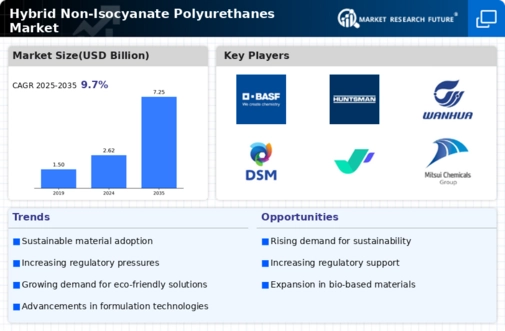Market Growth Projections
The Global Hybrid Non-Isocyanate Polyurethanes Market Industry is projected to experience robust growth in the coming years. With a market value anticipated to reach 2.62 USD Billion in 2024, the industry is set to expand significantly. Analysts forecast a compound annual growth rate (CAGR) of 9.7% from 2025 to 2035, indicating a strong upward trajectory. This growth is driven by various factors, including increasing demand for sustainable materials, technological advancements, and expanding applications across multiple sectors. As industries continue to innovate and adapt to changing consumer preferences, the market is likely to witness substantial developments, positioning it as a key player in the global materials landscape.
Technological Advancements in Production
Technological advancements play a crucial role in the Global Hybrid Non-Isocyanate Polyurethanes Market Industry. Innovations in production processes enhance the efficiency and quality of non-isocyanate polyurethanes, making them more appealing to manufacturers. For instance, the development of new catalysts and formulations allows for improved performance characteristics, such as durability and flexibility. These advancements not only reduce production costs but also enable the creation of specialized products tailored to specific applications. As a result, the market is likely to experience significant growth, with projections indicating a rise to 7.25 USD Billion by 2035, driven by these technological improvements.
Growing Demand for Eco-Friendly Materials
The Global Hybrid Non-Isocyanate Polyurethanes Market Industry experiences a notable increase in demand for eco-friendly materials. As environmental regulations tighten globally, industries are seeking alternatives to traditional polyurethane products that often contain harmful isocyanates. This shift is driven by consumer awareness and corporate sustainability goals. The market is projected to reach 2.62 USD Billion in 2024, reflecting a growing preference for sustainable solutions. Companies are increasingly investing in research and development to create non-toxic, biodegradable products, which aligns with the global trend towards greener manufacturing practices. This demand is expected to propel the market further as industries adapt to changing consumer preferences.
Increasing Applications Across Industries
The versatility of hybrid non-isocyanate polyurethanes contributes to their increasing applications across various industries, thereby driving the Global Hybrid Non-Isocyanate Polyurethanes Market Industry. These materials are utilized in sectors such as automotive, construction, and coatings, where their unique properties provide significant advantages. For example, in the automotive industry, they are used for lightweight components that enhance fuel efficiency. The construction sector benefits from their durability and resistance to environmental factors. As industries continue to explore the potential of these materials, the market is expected to grow at a CAGR of 9.7% from 2025 to 2035, reflecting the expanding scope of applications.
Rising Consumer Awareness and Preferences
Rising consumer awareness regarding health and environmental issues drives the Global Hybrid Non-Isocyanate Polyurethanes Market Industry. As consumers become more informed about the potential hazards associated with traditional polyurethane products, there is a marked shift towards safer alternatives. This trend is evident in various sectors, including furniture, automotive, and construction, where consumers actively seek products that minimize health risks and environmental impact. Companies responding to this demand are likely to gain a competitive edge, further stimulating market growth. The increasing consumer preference for non-toxic materials is expected to contribute to the market reaching 7.25 USD Billion by 2035.
Regulatory Support for Sustainable Practices
Regulatory support for sustainable practices significantly influences the Global Hybrid Non-Isocyanate Polyurethanes Market Industry. Governments worldwide are implementing stringent regulations aimed at reducing the environmental impact of chemical products, including polyurethanes. This regulatory landscape encourages manufacturers to adopt non-isocyanate alternatives, which are perceived as safer and more environmentally friendly. Incentives for research and development in sustainable materials further bolster this trend. As a result, the market is poised for growth, with an anticipated increase in value to 2.62 USD Billion by 2024, as companies align their operations with regulatory expectations and consumer demands for greener products.




















